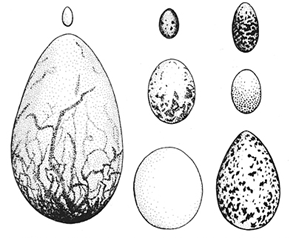|
Females of all vertebrates produce eggs, but the reptiles "invented" the eggshell -- a device that could keep the egg from drying out and allow reproduction away from water (or, at least, from extremely moist environments). With the exception of the platypus and echidna, mammals provide the developing embryo with a suitable environment within the mother's womb. The other major group of reptile descendants, the birds, not only have continued the reptilian tradition, but have evolved eggs of an improved design in a wide variety of sizes, shapes, colors, and textures. Bird eggs are virtually self-contained life-support systems. All they require for the embryo to develop properly are warmth and oxygen. Oxygen diffuses into the egg through microscopic holes formed by the imperfect packing of the calcium carbonate crystals that compose the eggshell. There are not many of these pores -- for example, they make up only about 0.02 percent of the surface of a duck egg. Carbon dioxide and water vapor diffuse outward through the same pores. Birds can lay their eggs in even drier environments than reptiles, because when the fatty yolk is broken down to provide energy for the developing embryo, water is produced as a by-product. Reptile eggs primarily use protein as a source of energy and do not produce as much "metabolic water." The proportion of yolk differs between altricial and precocial birds. The former, which hatch so undeveloped that they require significant parental care and thus need less stored energy, generally have eggs that contain about 25 percent yolk. Precocial birds, which can walk and feed themselves shortly after hatching, have eggs with about 40 percent yolk (67 percent in megapodes, inhabitants of Australia and Pacific islands which upon hatching are virtually ready to fly). Interestingly, in spite of this difference, and although bird eggs range in weight from about one hundredth of an ounce (small hummingbird) to three and a half pounds (ostrich), all bird eggs lose water amounting to about 15 percent of their original weight during incubation. This careful control is probably a result of the necessity to keep the water content of the developing chick's tissues constant even though metabolic water is continually being produced. Small birds tend to lay proportionately large eggs; the egg of a wren weighs about 13 percent of the wren's weight, while an ostrich egg weighs less than 2 percent of an adult's weight. As might be expected, the eggs of precocial birds tend to be heavier in proportion to body weight than those of altricial birds -- the parents must "invest" more in the egg to give the chick the energy and materials required for more advanced development within the confines of the shell.
Although most are "egg-shaped," some eggs, such as those of owls, are nearly spherical. Fast-flying, highly streamlined birds such as swifts and hummingbirds tend to lay long, elliptical eggs, while those of auks, guillemots, and shorebirds are more pointed at the narrow end. Such "top-shaped" eggs can be closely packed with the pointy ends inward, helping adults to efficiently cover them during incubation. Top-shape appears to be especially advantageous for birds that nest on bare ground or cliffs because, when disturbed, pointy eggs tend to roll in circles, rather than away from the nest (and possibly over the cliff). Bird eggs vary enormously in color, and there is also variation in the surface texture of eggs -- for instance, those of many ducks are greasy and water-repellent. Shells vary in thickness, too, and may be subject to thinning and weakening by environmental pollutants that interfere with the bird's calcium metabolism. Why have birds not "advanced" beyond egg laying and started to bear their young alive like mammals? People have claimed that viviparity (live-bearing) is incompatible with flight, but bats disprove that hypothesis. Daniel Blackburn of Vanderbilt University and Howard Evans of Cornell point out that the evolutionary path to viviparity usually involved retaining eggs for longer and longer periods until they finally hatch within the female's body. Blackburn and Evans argue that egg retention would offer little advantage to birds, and several disadvantages. Among the latter are a loss of productivity -- since females obviously could not retain many eggs until they hatched -- and probably increased risk to the mother associated with the added burden of weight. In addition, in many species, the contribution of the male to the care of offspring would be lost and it has recently been suggested that a female bird's body may be too hot for proper egg development. It seems likely, therefore, that evolving viviparity would be a step backward for birds -- they are doing just fine laying eggs. SEE: Incubation: Heating Eggs; Average Clutch Size; Variation in Clutch Sizes; DDT and Birds; Empty Shells. Copyright ® 1988 by Paul R. Ehrlich, David S. Dobkin, and Darryl Wheye. |
